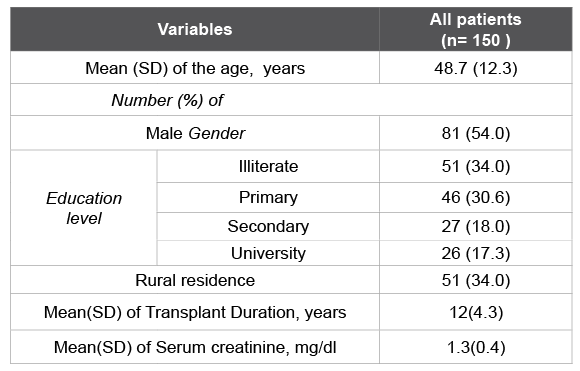
Table 1: Socio-Demographic Characteristics of transplanted Sudanese patients

Magdi M Salih1 Otba M Hassan2 Gasim I Gasim3* Ishag Adam4
1Department of Histopathology and Cytology, Faculty of Medical Laboratory Science, University of Khartoum, Sudan*Corresponding author: Gasim I Gasim, El Neelain School of Medicine, El Neelain University, Khartoum, Sudan, E-mail: gasimgsm@yahoo.com
Polyomavirus; Transplantation; PCR
BK Polyomavirus is ubiquitous worldwide and latent in humans. Serologic evidence of previous exposure can be obtained in the majority of adults and immune-compromised subjects are more prone to viral reactivation [1], while kidney biopsies comparing a transplanted group of patients to normal subjects proved its exclusive existence among transplanted subjects [2]. It has been shown that one third of kidneytransplant subjects had asymptomatic viruria [3] and BK Polyomavirus associated nephropathy with graft was observed in 60 % of patients [4,5]. Diagnosing cases of BK Polyomavirus are effective in preventing progressive graft function and are widely recommended [6]. Therefore, there is a need for aggressive vigilance to detect the viral infection in its earlier stages before irreversible graft injury ensues. The current study was conducted to determine the incidence of BK Polyomavirus among transplanted Sudanese patients.
A cross-sectional study was conducted to determine the incidence BK polyomavirus among transplanted Sudanese patients using the two commonly used methods; urine cytology and polymerase chain reaction (PCR). After signing an informed consent basic socio-demographic characteristics were gathered (table 1). Then urine specimens were obtained from all the patients attending the transplant clinics of the Sudanese Renal Transplantation Society. All of the patients were of African origin; the kidney grafts were live donated grafts as the case in all kidney transplants in Sudan; history about mechanical injury or ishaemic reperfusion could not be obtained, while none of these patients underwent induction with antithymocyte globulin. The immunosuppressive regime used was Tacrolimus, Azathioprine and Prednisolone. Urine samples were collected and centrifuged. From the deposits, smears were prepared in microscopic slides, fixed while wet and stained with Papanicolaou stain and then examined microscopically for presence of BK Polyoma virus inclusions. The remaining deposit was prepared for DNA extraction for PCR using guanidine technique. The following oligonucleotide sequence, derived from the BKV (Dunlop strain; GenBank accession no. (NC001538) capsid protein-1 (VP-1) gene) [7] was used for detection of viral DNA.

Table 1: Socio-Demographic Characteristics of transplanted Sudanese patients
Ethical considerations the proposal of this study was approved by the research board ethical committee of Faculty of Medical laboratory science Sudan University for Science and Technology.
Decoy cells, nuclear inclusions associated with BK polyoma virus infection (defined as cells with discrete intranuclear basophilic or amphophilic inclusions) were detected in 5 (3.33%) out of 150 specimens. This incidence was comparable with that Almobarak et al have observed (4.4%) before in Sudan [8].
Quantitative PCR was able to detect BKV DNA in (7.33%) of the total number of samples. There was no graft loss detected in a prospectively observed series of patients, among whom five patients were diagnosed to have viral nephropathy [9]. On the other hand, previous studies reported graft loss rates approaching 60% (3-5). Urine cytology is a technically simple procedure [9]. On the other hand, PCR have the capacity to detect additional cases of viruria, a thing that could be reflected in terms of benefit in close clinical monitoring and adjustment of immunosuppression. Another concern with urine cytology is that interpretation needs a trained pathologist, especially in cases where discrete viral inclusions are not present. Difficulties in distinction between polyomavirus infection, reactive atypia, and urothelial dysplasia might be experienced. This is quite an important and valid point because Polyomavirus nephropathy is rarely caused by JC virus [10]. The utilization of PCR in screening overcomes these limitations of cytology [11]. It is crucial that a quantitative technique be used, and the sensitivity of the assay should fall in the range of 100 to 1,000 copies/mL. PCR technology is not readily available in the community hospital; however, this limitation does not apply to Sudanese transplant patients as all of them have their follow up at equipped centers.
Download Provisional PDF Here
Article Type: Short Communication
Citation: Salih MM, Hassan OM, Gasim GI, Adam I (2015) Polyomavirus among Transplanted Sudanese Patients. J Emerg Dis Virol 1(1): doi http:// dx.doi.org/10.16966/2473-1846.105
Copyright: © 2015 Salih MM, et al. This is an openaccess article distributed under the terms of the Creative Commons Attribution License, which permits unrestricted use, distribution, and reproduction in any medium, provided the original author and source are credited.
Publication history:
All Sci Forschen Journals are Open Access